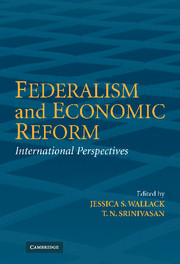Book contents
- Frontmatter
- Contents
- List of Contributors
- Acknowledgments
- 1 Analyzing Federalism: Stylized Models and the Political Economy Reality
- 2 Federalism in Argentina and the Reforms of the 1990s
- 3 Australia: Central Fiscal Dominance, Collaborative Federalism, and Economic Reform
- 4 The Brazilian Federation: Facts, Challenges, and Perspectives
- 5 Changing with the Times: Success, Failure, and Inertia in Canadian Federal Arrangements, 1945–2002
- 6 Fiscal Federalism and Economic Reform in China
- 7 Indian Federalism, Economic Reform, and Globalization
- 8 Mexico's Decentralization at a Crossroads
- 9 Transfer Dependence and Regional Disparities in Nigerian Federalism
- 10 Conclusions and Lessons for Further Study
- Index
- References
3 - Australia: Central Fiscal Dominance, Collaborative Federalism, and Economic Reform
Published online by Cambridge University Press: 25 July 2009
- Frontmatter
- Contents
- List of Contributors
- Acknowledgments
- 1 Analyzing Federalism: Stylized Models and the Political Economy Reality
- 2 Federalism in Argentina and the Reforms of the 1990s
- 3 Australia: Central Fiscal Dominance, Collaborative Federalism, and Economic Reform
- 4 The Brazilian Federation: Facts, Challenges, and Perspectives
- 5 Changing with the Times: Success, Failure, and Inertia in Canadian Federal Arrangements, 1945–2002
- 6 Fiscal Federalism and Economic Reform in China
- 7 Indian Federalism, Economic Reform, and Globalization
- 8 Mexico's Decentralization at a Crossroads
- 9 Transfer Dependence and Regional Disparities in Nigerian Federalism
- 10 Conclusions and Lessons for Further Study
- Index
- References
Summary
INTRODUCTION
The Australian federation, as it has evolved over the past century, has a number of distinguishing characteristics. A high degree of separation of taxes with federal government control over major tax bases has led to a very high level of vertical fiscal imbalance. Much of the dynamics of center–state relations occurs against the backdrop of fiscal dominance by the federal government. Borrowing by all levels of government is subject to a process of Loan Council endorsement. With regard to redistribution, Australia employs the most elaborate system of horizontal fiscal equalization of any federation.
During the 1980s a worsening external debt position helped focus attention on structural weaknesses in the Australian economy. Efforts to rectify these weaknesses and increase public and private sector efficiency have led Australia to undergo a wide range of economic reforms, including some changes to federal institutions and arrangements, over the past two decades. There have been changes to the borrowing rules for national and subnational governments, a new tax-sharing arrangement, and reviews of intergovernmental administrative bodies. A significant increase in collaborative federalism over the past decade has facilitated major reforms to Australia's internal markets.
Over the past decade the Australian federal system has delivered substantial reform of the nation's internal markets, which has allowed Australia to increase its competitiveness and take advantage of greater global integration.
- Type
- Chapter
- Information
- Federalism and Economic ReformInternational Perspectives, pp. 85 - 142Publisher: Cambridge University PressPrint publication year: 2006
References
- 4
- Cited by



